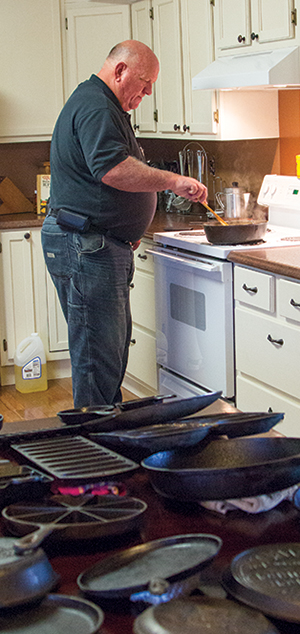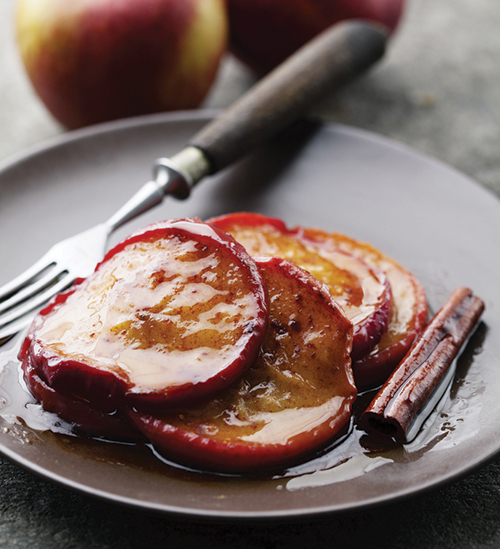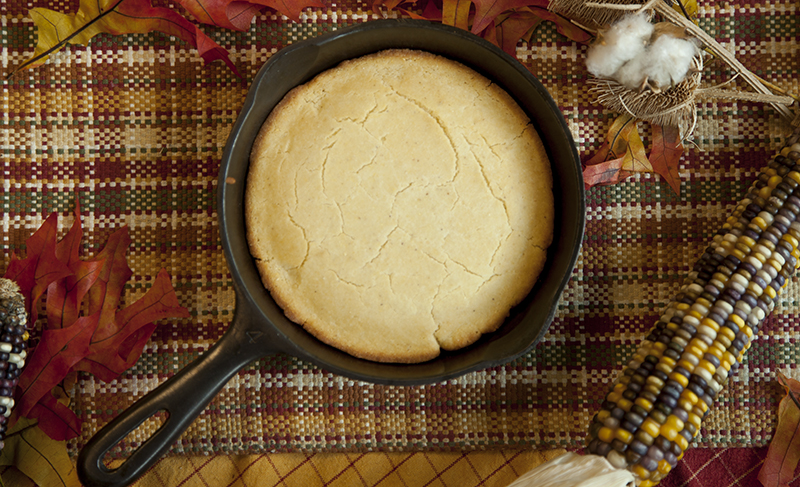By Jennifer Kornegay
Cast iron cookware: the must-have tool for your Southern kitchen
|Click here to view video of Eddie Brandon in his kitchen|
I cook a lot, and a quick inventory of my kitchen equipment proves it. I’ve got expensive pots and pans, a fabulous immersion blender, several sizes of food processors, a fancy peppermill and more. But if a meteor struck my kitchen and destroyed it all, there’s only one thing I’d truly miss: my grandmother’s 10-inch cast iron skillet.
I love the weight of it in my hand, and the memories it evokes each and every time I pull it from its resting place in a bottom cabinet. It’s a time machine that transports me back to my grandmother’s aproned side, helping her whip up whatever deliciousness she was making.
But in truth, if a meteor did hit my home, that skillet is the one thing that would probably withstand the blast. Cast iron is almost indestructible, and that’s one reason cast-iron skillets are handed down through generations. The other reason? They are must-have tools for creating several staples of Southern cuisine.

Why cook with cast iron?
Your grandmother knew what she was doing. Cast iron is the original non-stick cookware, meaning you can use far less oil or fat when preparing everything from chicken thighs to veggies in your skillet, but that’s only one of its health benefits. The other two are the lack of chemicals often found in modern non-stick pans, and the fact that cast iron is just that: iron. Your skillet will leach a small amount of the mineral into whatever you’re cooking, adding a little extra iron to your nutritional intake.
The real reason to cook with cast iron is taste. Iron is an excellent conductor, and since it heats evenly and consistently, it’s far easier to get a good sear on meat and keep those flavorful juices in. It’s also better at browning cornbread and crisping the crust on fried chicken.
Eddie Brandon, a staking engineer for the North Alabama Electric Co-op in Stevenson, Ala., knows this well. An avid cook, he’s also a cast-iron skillet collector. His cornbread has become famous among his co-workers, a treat they beg him to bring to the office over and over again. And he couldn’t do it without cast iron.
“I started using cast iron because my mom and grandmother did,” he says, “but I keep using it because for cornbread, there’s just no other pan or skillet that will do it right.” He stresses that only cast iron can bake cornbread evenly, and only cast iron delivers that beloved tawny brown crust. “That’s the best part,” he says.
But he cooks far more than cornbread in his many cast iron containers. His collection has grown to include close to 40 pieces of varying sizes and shapes. Other favorite dishes he makes in cast iron are fried catfish (in a Dutch oven), creamed corn and fried potatoes (both in a skillet). “They all get a better flavor in cast iron,” he says.
How to care for cast iron
It’s hard to argue with all the reasons to use cast iron, yet some people still shy away from it, probably due to concerns over its care. But that’s a mistake. Once you know the basics, cast iron is as easy, if not easier, to clean and keep as any other tool in your culinary arsenal.
First, you can wash it, and yes, you can even use soap, although Eddie Brandon doesn’t recommend it. The best way to clean cast iron is to run hot water on it while it’s still warm (but cool enough to handle) and wipe it out with a dry dishcloth.
You can use a bit of mild dish soap, but you really don’t need it. Most food bits should come off clean with the water, and if you need to give them a little nudge, use a soft brush or make a paste with Kosher salt and give it a rub.
There are a few don’ts: Don’t soak or submerge your cast iron in water and don’t put it in the dishwasher. And a few do’s: Do feel free to use metal utensils with your cast iron cookware (one more way it’s better than non-stick pans), and do dry it completely before putting it away to stave off rust, and wipe a little more oil on the inside.
But your cast iron skillet is already rusty you say? No problem. You can revive it quick with a bit of fine steel wool and another quick rinse.
“But I’ve tried using my handed-down skillet, and things stick!” you insist. Again, no big deal. That means it’s time to re-season, which is simple. Give it a good rinse and dry it. Add some vegetable oil or shortening, spreading it around the inside with a paper towel, and bake upside down in a 350-degree oven for about an hour. Place a sheet pan with aluminum foil on the rack below your skillet to catch any drips, and let the skillet cool in the oven once the hour is up.
“Well, I got a new cast-iron skillet, so how can I tell if it is seasoned already?” If it came from Lodge, the most popular and prolific maker of cast iron in the country, it has been seasoned. If not, follow the same steps for re-seasoning to get it ready for cooking.
What to cook in cast iron
(other than corn bread)
Join Eddie and break out of your corn bread box. You can cook almost anything in cast iron: steak (the skillet stays screaming hot so it sears meat perfectly), grilled cheese sandwiches (thanks to even heating), the dishes Eddie is so fond of, and even desserts. Try this easy recipe that pairs butter with sugar and fall’s favorite fruit to create a topping for pound cake, ice cream, cardboard, whatever.
[box]
Eddie’s Can’t Fail Corn Bread
1 cup Martha White Enriched Cornmeal
(NOTE: Not cornmeal mix)
1 egg
1½ cups buttermilk
Preheat your oven to 425 degrees. Put enough oil to cover the bottom of your skillet. Eddie recommends bacon grease. Put the skillet and fat in the oven and let it get hot. Mix the cornmeal, egg and buttermilk in a bowl. Pour the batter into the hot grease and place back in the oven for 20-25 minutes or until the top is thoroughly browned.
 Skillet Sugared Apples
Skillet Sugared Apples
3-4 large apples, any variety
3 tablespoons butter
1/3 cup brown sugar
1 tsp cinnamon
½ tsp nutmeg
Core the apples and slice them into thin wedges, approximately ¼ inch wide. Heat your cast iron skillet over medium heat and add the butter. Cook the apples in the melted butter for 6 to 7 minutes or until fork tender. Add the sugar and spices and stir. Cook for another 4 to 5 minutes or until the sugar creates a thick syrup. Remove from heat and let cool.
[/box]






